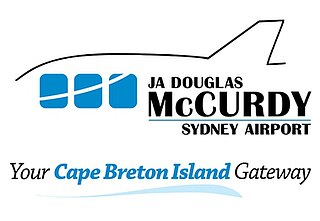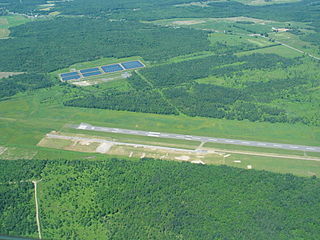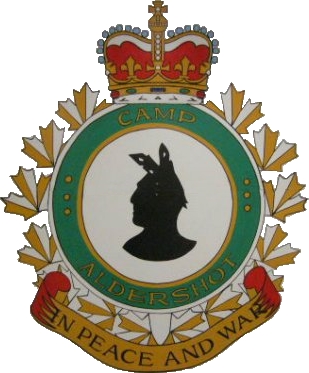
The British Commonwealth Air Training Plan (BCATP), or Empire Air Training Scheme (EATS) often referred to as simply "The Plan", was a massive, joint military aircrew training program created by the United Kingdom, Canada, Australia and New Zealand, during the Second World War. BCATP remains one of the single largest aviation training programs in history and was responsible for training nearly half the pilots, navigators, bomb aimers, air gunners, wireless operators and flight engineers who served with the Royal Air Force (RAF), Royal Navy Fleet Air Arm (FAA), Royal Australian Air Force (RAAF), Royal Canadian Air Force (RCAF) and Royal New Zealand Air Force (RNZAF) during the war.

The London International Airport is an international airport located in London, Ontario, Canada. It is located 5 nautical miles northeast of the city of London, Ontario and is classified as an airport of entry by Nav Canada. In 2011, the airport was listed as the 20th busiest airport in Canada in terms of aircraft movements with 94,747 travels. The airport posted a record 683,000 travelers in 2019 and is forecasting 400,000 passengers in 2023. It provides services for cargo airlines and year-round flights with Air Canada Express and WestJet.

Shearwater Heliport(ICAO: CYAW), formerly known as Canadian Forces Base Shearwater and commonly referred to as CFB Shearwater and formerly named HMCS Shearwater, is a Canadian Forces facility located 4.5 nautical miles east southeast of Shearwater, Nova Scotia, on the eastern shore of Halifax Harbour in the Halifax Regional Municipality. Following a base rationalization program in the mid-1990s, the Canadian Forces closed CFB Shearwater as a separate Canadian Forces base and realigned the property's various facilities into CFB Halifax. These include:
Canadian Forces Station Debert was a Canadian Forces station located in Debert, Nova Scotia. It was most recently used during the Cold War as a communications facility and was home to a "Regional Emergency Government Headquarters" (REGH) complex, more commonly known by their nickname "Diefenbunker."
Debert is an unincorporated farming community in Nova Scotia, Canada. Located in the central-western part of Colchester County, it is approximately 20 km (12 mi) west of Truro.
Brampton-Caledon Airport is a privately owned general aviation airport in Caledon, near Brampton, Ontario, Canada, northwest of Toronto.

Canadian Forces Base Greenwood, or CFB Greenwood, is a Canadian Forces Base located 1.5 nautical miles east of Greenwood, Nova Scotia. It is primarily operated as an air force base by the Royal Canadian Air Force and is one of two bases in the country using the CP-140 Aurora and CP-140A Arcturus anti-submarine/maritime patrol and surveillance aircraft. Its primary RCAF lodger unit is 14 Wing, commonly referred to as 14 Wing Greenwood.

Canadian Forces Base Comox, commonly referred to as CFB Comox or 19 Wing, is a Canadian Forces Base located 2.5 nautical miles north northeast of Comox, Vancouver Island, British Columbia. It is primarily operated as an air force base by the Royal Canadian Air Force (RCAF) and is one of two bases in the country using the CP-140 Aurora anti-submarine/maritime patrol and surveillance aircraft. Its primary RCAF lodger unit is 19 Wing, commonly referred to as 19 Wing Comox.

Stanley Airport is located in Stanley, Hants County, Nova Scotia, Canada, approximately 12 nautical miles northeast of Windsor.

JA Douglas McCurdy Sydney Airport is a regional airport located in Reserve Mines in the Canadian province of Nova Scotia. The airport serves the Cape Breton Regional Municipality (CBRM) and the surrounding areas of Cape Breton Island. McCurdy Sydney Airport has the distinction of being the oldest public airport in Nova Scotia, first licensed on August 3, 1929.

Yarmouth Airport is a registered aerodrome located in Yarmouth County, Nova Scotia, Canada. It began as a World War II Royal Air Force training base.

The Roland-Désourdy Airport is located 3.4 nautical miles west-southwest of Bromont, Quebec, Canada.

Gimli Industrial Park Airport is a civilian airport and former military field located 2 nautical miles west of Gimli, Manitoba, Canada.

North Battleford Airport is located 1.5 nautical miles east of North Battleford, Saskatchewan, Canada.

Hawarden Airport, is an airport near Hawarden in Flintshire, Wales, near the border with England and 3.5 NM west southwest of the English city of Chester.

A Volunteer Gliding Squadron (VGS) is an aircraft squadron of the Royal Air Force (RAF) which provides flying training in glider aircraft for Royal Air Force Air Cadets. All current operational Volunteer Gliding Squadrons operate a sole type of aircraft, the Grob G103A Twin II Acro, a conventional winch-launched tandem-seat sailplane known by its British military designation, Viking T1.

5th Canadian Division Support Group Detachment Aldershot is a training facility for 5th Canadian Division of the Canadian Army. It is located in Kings County, Nova Scotia.

During World War II civilian flying schools, under government contract, provided a considerable part of the flying training effort undertaken by the United States Army Air Forces.
CFB Rivers was a Royal Canadian Air Force base located 5 km (3.1 mi) southwest of Rivers, Manitoba, Canada, at the junction of Manitoba Highway 25 and Manitoba Provincial Road 259.

Markham Airport or Toronto/Markham Airport is a private aerodrome operating 2.6 nautical miles north of Markham, Ontario, Canada near Toronto.


















